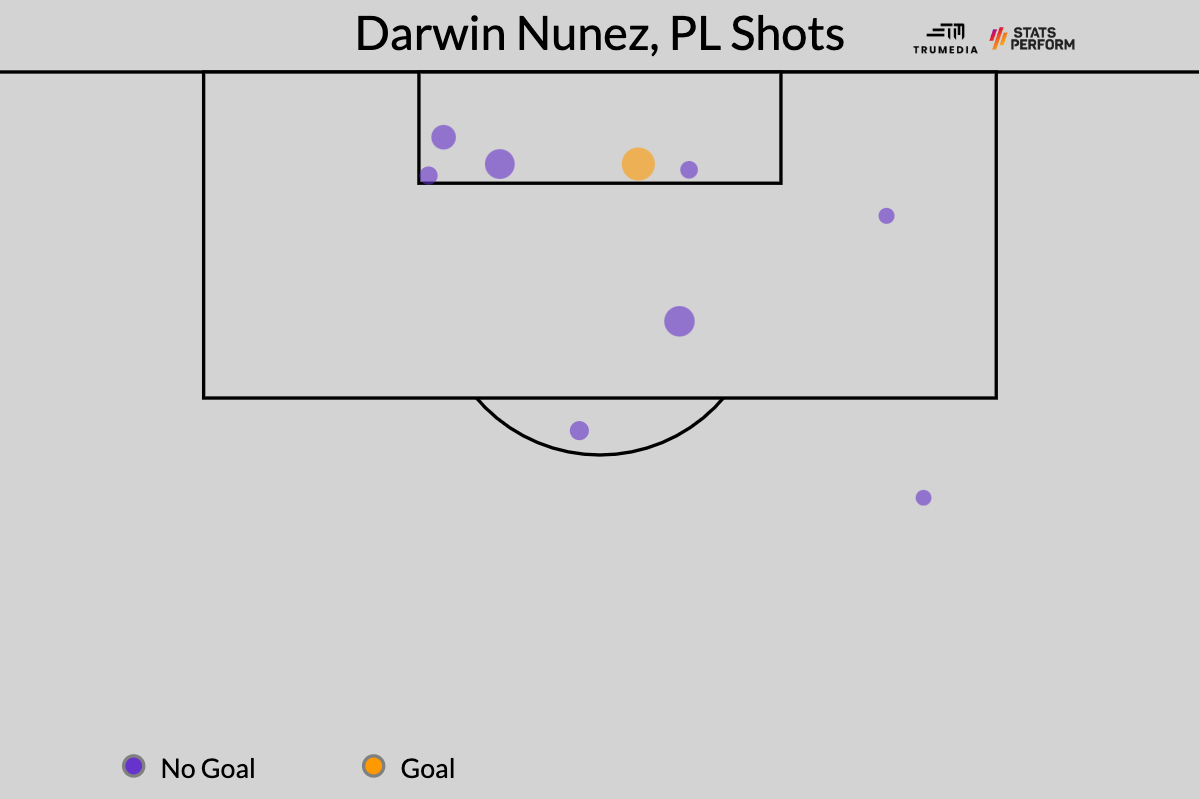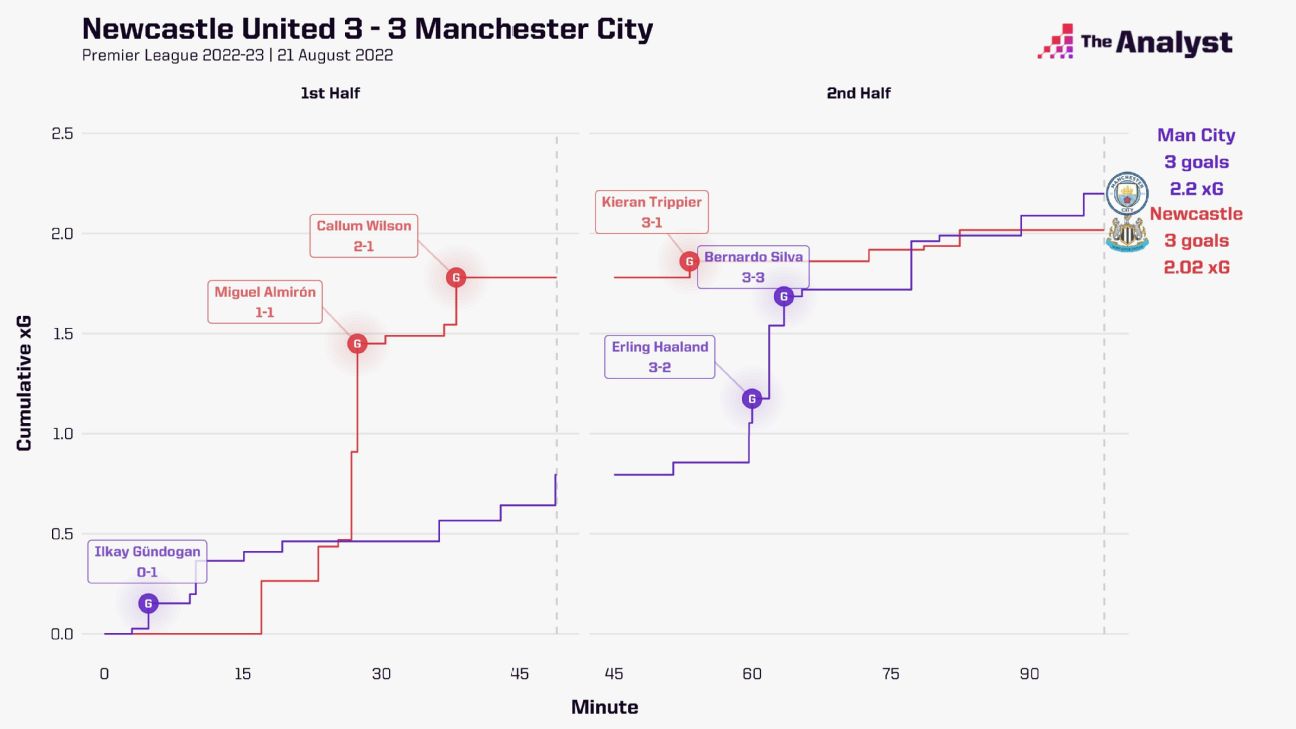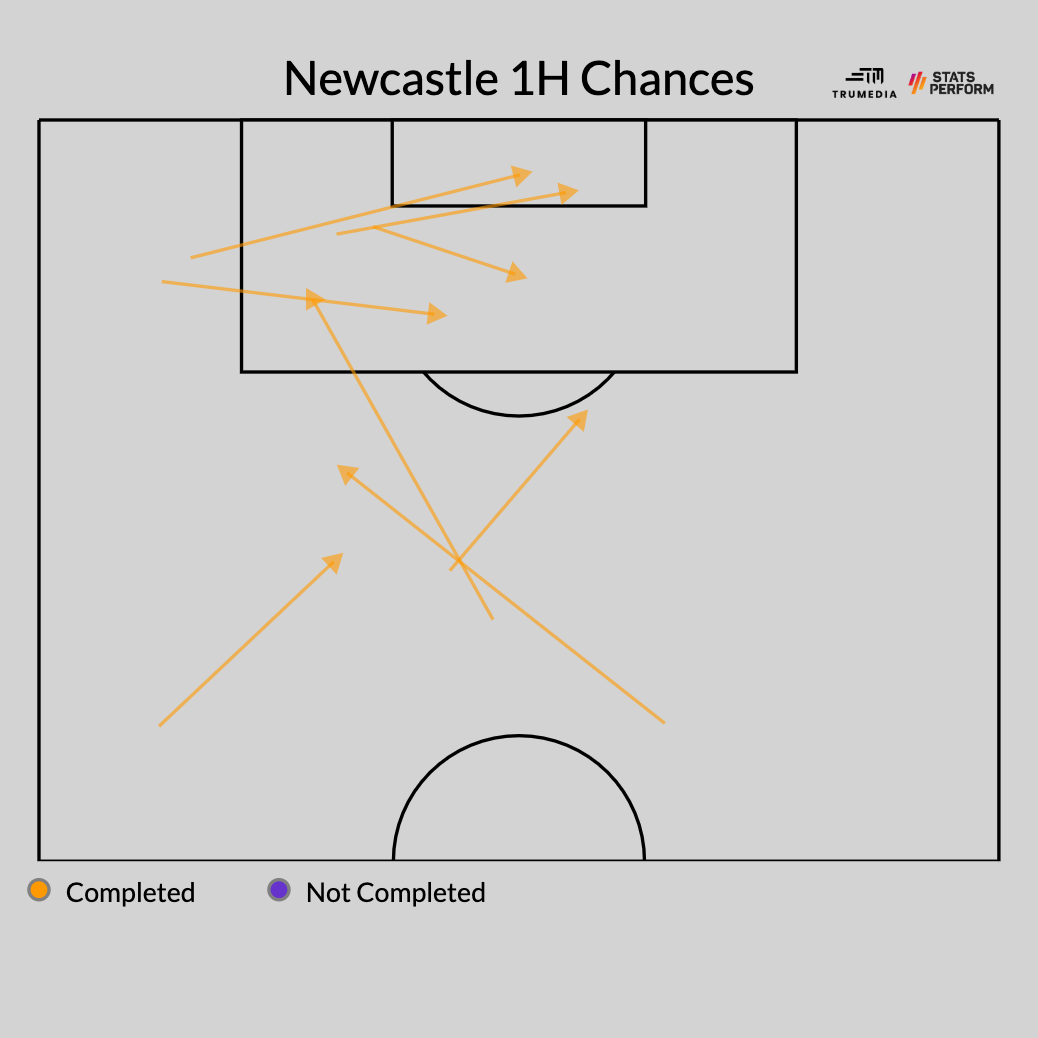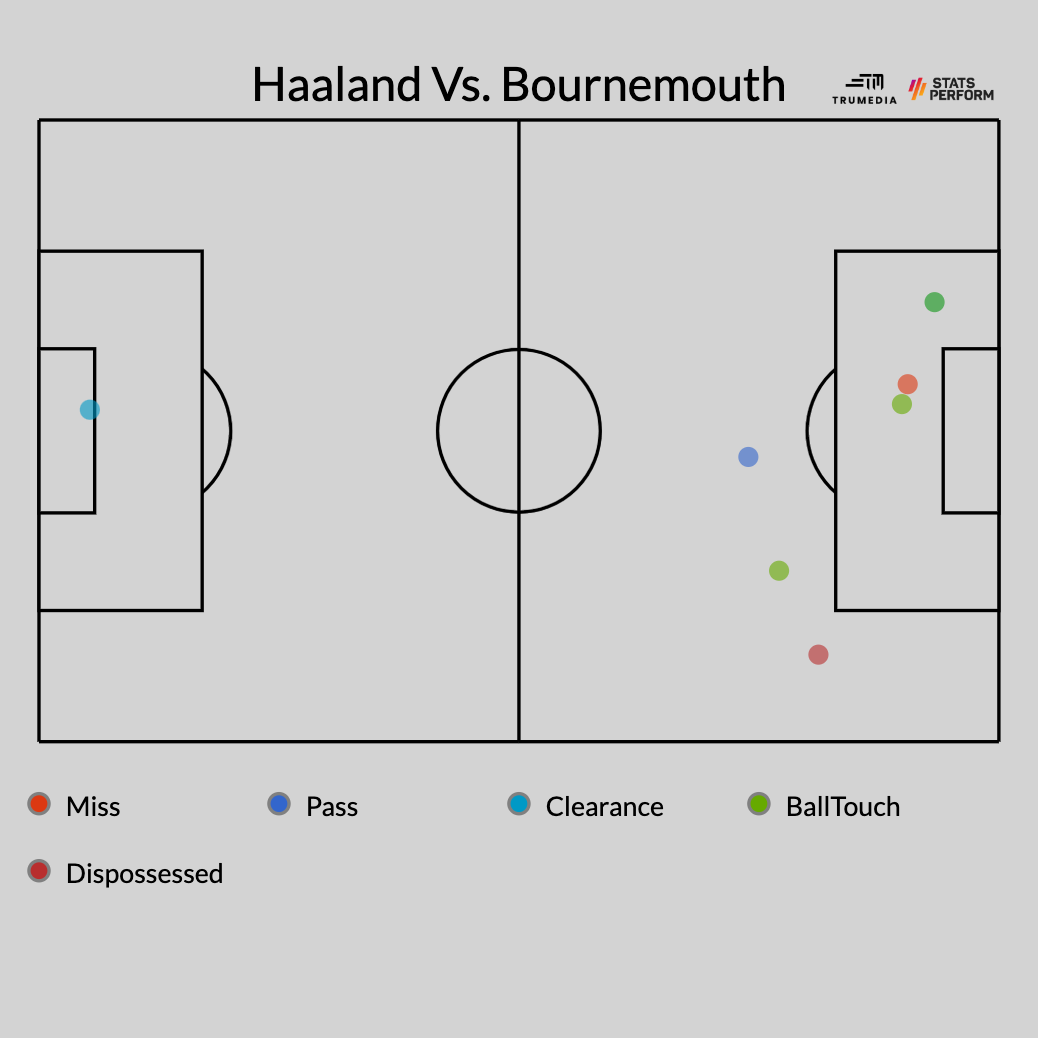You forgot what that was like, didn't you? The last time Liverpool and Manchester City both dropped points on a Premier League matchday was April 10 ... when they played each other to a 2-2 draw. Before that? It was Oct. 30, when City lost 2-0 to Palace and Liverpool drew 2-2 with Brighton. Just three weeks into this season, it's already happened once.
Over the past four seasons, Liverpool and City have set absurd standards for consistency: City won 358 points, Liverpool were one back on 357, and no one else took more than 279. But thanks to aging squads, key departures, expensive new arrivals requiring tactical concessions and broader improvement across the rest of the league, both teams have looked vulnerable at the same time for the first time in a long time.
So let's take a look at some of their issues and see what they might mean for the final 35 matches.
 LIVERPOOL
LIVERPOOL
Black Magic
When he addressed the media before last Monday's match against Crystal Palace, Jurgen Klopp blamed a witch. I'm not using figurative language; I am describing, perfectly accurately, exactly what he did.
"The week was crazy," he said. "I have experienced a lot of weeks, but that was like we had a witch in the building. Honestly, like every day somebody else pulled out (of training) for the craziest reasons."
More from Ryan O'Hanlon:
- Proposing a better box score for soccer: Are we explaining the game properly?
- Why are Barcelona selling off their future?
- Is the Bundesliga too weird for Bayern Munich?
Liverpool had 15 different players reach at least 900 minutes in the league last season. We can think of this as the core of players that created the capacity for Liverpool to win 90-plus points and reach the final of every possible cup competition. Joel Matip played the fifth-most minutes last year, and he's only played 90 out of a possible 270 this season. His deputy (and presumed replacement) Ibrahima Konate hasn't featured once. Both Fabinho and Jordan Henderson have featured in just two-thirds of the minutes. Thiago has only played 51 total minutes, while last year's fourth midfielder, Naby Keita, hasn't played at all.
Oh, and then there's Sadio Mane, who played more than everyone other than Alisson, Virgil van Dijk and Trent Alexander-Arnold last season, and who now plays for Bayern Munich. His in-house replacement, Diogo Jota, hasn't played a single minute. His newly acquired replacement, Darwin Nunez, has only played 96.
Now, not all of that is down to injuries. Nunez head-butted a guy and is serving a three-game suspension, while Fabinho was benched against Manchester United and got an early hook against Fulham. But most of it is injury-related and regardless of the reason, the point remains the same: most of Liverpool's most-used players last season haven't played much this season.
Any explanation for two points through three games starts -- and very nearly ends -- here.
Marginal Declines
While City have unlocked their levels of elite play with Fernandinho and Walker as their skeleton keys, Liverpool have instead asked the question, "What if we just made the whole plane out of a skeleton key?"
- Klopp: Premier League table 'not nice to look at'
- Reaction: Man United kick-start Ten Hag era with big win
Last season, Liverpool won possession in the attacking third 7.6 times per game; no one else was above 6.3. They allowed the lowest pass-completion percentage outside of their defensive third. They allowed the fewest opponent passes per defensive action, and they drew opponents offside 3.8 times per match -- more than twice the league average and significantly more than City's second-best mark of 2.5. When the ball got into the opposition's defensive third, Liverpool leveraged all 11 players to do everything they could to keep it there. And it worked: they conceded just 26 goals in 38 matches, joint-best with City.
However, it's really hard to turn that kind of approach into that defensive record. You have to have a press that's firing on all cylinders. You have to have midfielders and fullbacks and attackers who don't lose the ball in dangerous moments. You need to have a midfield that commits professional fouls at the right moment. You need to have a pair of center-backs who know when to draw the opponent offside and when to chase down the ball over the top. And you need to have a keeper who can save the 1-on-1 whenever the ball gets through all those safeguards.
There's no single player who holds it all together; rather, every single player has to hold it all together.
Without Mane and, particularly Jota, who is the best presser on the team and one of the best in the world, the front three hasn't been as effective at winning the ball back. With James Milner and Harvey Elliott taking the places of Keita, Henderson, Fabinho and Thiago, the midfield isn't as secure with or without the ball. That puts more pressure on Trent Alexander-Arnold to both make plays in possession (usually good!) and to defend (mostly bad!). Then, without either Matip or Konate, the offside line hasn't been as effective, and neither has the defending in the final-third. And on top of all that, well, Alisson can't save everything.
Liverpool have won possession in the attacking third nearly three fewer times per game this season (down to 5.0), and they've drawn opponents offside one fewer time per game (down to 2.7), too. And that's all despite playing much more open games than last season so far: 106 possessions per match, up from 99.5. They've been worse in transition this season and yet, so far, they've played in a way that encourages even more of them. Three of the five goals they've conceded have came from nearly identical, simple situations, as the writer Andrew Beasley pointed out during the loss to Manchester United:
Win the ball and make one pass from in midfield against Liverpool:
— Andrew Beasley 💙 (@BassTunedToRed) August 22, 2022
Penalty for Fulham, goal for Zaha, goal for Rashford. pic.twitter.com/B5ZdGUoBiW
They've allowed 1.7 goals per game so far this season, compared to 0.7 this season. It's not quite that bad: 1.3 xG compared to 1.0 a year ago. They're also allowing a shot-and-a-half more per game (up to 9.3 from 7.8) and two more touches in the penalty area (17.3, up from 15.3).
It might not seem like much, but that's how Klopp's system works. Defensively, the difference between total domination and what we've seen these first three weeks isn't much.
No Goals
As someone who works with clubs in Europe put it to me after the United match: Liverpool only have one goal scorer. While Salah is one of the greatest goal scorers in Premier League history, last season Mane scored 16 goals in the league and Jota added 15. No one else on the team had more than five. For all his irreplaceable qualities, Firmino has scored more than 11 goals in a season just once since joining Liverpool. Luis Diaz, meanwhile, does a ton of great ball-carrying from the left wing, but he still really hasn't shown that he's capable of replacing Mane's scoring load yet. And Jota, of course, hasn't yet played a minute this season.
Which brings us to Nunez. Despite only featuring in 96 total minutes this season, he's generated the fifth-most total expected goals in the league, per FBref: 1.6, behind Haaland, Rodrigo of Leeds, Arsenal's Gabriel Jesus, and some guy named Harry Kane. Nunez has attempted nine total shots, which is tied for seventh-most in the league and would come out to 8.44 per 90 minutes. The league leader last season was Salah ... with 4.37.

To continue on with the small sample-size theater, Liverpool's xG differential with Nunez on the field is plus-1.65 per 90 minutes, the second-best mark in the league. Put more simply, they were dominant with Nunez on the field in the first two matches.
Of course, he's only been out there for about a third of the minutes and Liverpool have also played a chunk of the non-Darwin minutes down a man because Darwin head-butted Joachim Andersen and got sent off at the beginning of the second half of the Crystal Palace match. Overall, Liverpool are taking more shots than last season, but creating a full expected goal fewer: 1.6 per game, down from 2.6.
While City have some fine-tuning to do, the path forward for Liverpool seems like it's going to take a bit more work to find. They're still the favorites to finish second, as they should be. A lot of weird stuff can happen in any given three game period, and Liverpool were essentially a title-winning-level team from March of 2021 through the end of last season. A couple of bad games shouldn't erase that much bigger baseline of excellence.
More from ESPN FC:
- Which clubs make the most profit in the transfer window?
- Connelly: Your cheat sheet to enjoying the European soccer season
- Ranking every "Big Six" transfer in Premier League history
They've gone down a goal early in all three of their matches, which has put an even bigger stress on their currently limited attack and has encouraged them to press even harder, which has then put even more stress on the currently weaker midfield and center-back pairing. They're not going to keep conceding the first goal in every match, and once they start taking some leads, I suspect that the floodgates will start to open as their opponents won't be able to sit in a shell and play for the counter. They also just haven't scored any real easy goals yet -- from set pieces or from a high turnover -- and a couple of those will open up all kinds of space and also help out the defense, too, since the press won't need to be as wild as its been with the team chasing deficits.
But just because we should expect Liverpool to get better doesn't mean we should expect them to get better by doing what they've been doing. The Milner-Henderson pairing in the midfield, especially without Fabinho and with a fourth-or-fifth string center-back behind it, just doesn't seem to have the legs to play the way Klopp wants to play. With Keita's future with the club unclear and Thiago only really reliable for some 1,200 minutes a year anyway, how do you account for that? It doesn't seem like they're going to sign a midfielder, so there's going to need to be some other kind of in-house solution.
While the degrees of their problems aren't quite comparable, one thing suddenly seems true for both Liverpool and City: If either one is going to reach the levels they've reached over the past four years, it's going to look a lot different than what we've seen so far.
 MANCHESTER CITY
MANCHESTER CITY
When they lose control, it can get ugly
After City went up in the fifth minute through Ilkay Gundogan on Sunday, Newcastle simply just pummeled the visitors with a barrage of haymakers that only really seemed to end because the referee had to blow the halftime whistle. This Stats Perform chart, which shows the progression of the expected goals accumulated over the course of the match, shows just how one-sided the first half was. There's no back-and-forth -- just big Newcastle chance after big Newcastle chance.

City conceded eight shots in the first half -- tied for the most in the first half of a Premier League game since Guardiola took over in 2016. The 1.63 expected goals conceded, meanwhile, was the third-most conceded in a Premier League first half under Guardiola. And Newcastle registered 15 touches inside the City penalty area -- the third-most conceded in the Guardiola era, and the most since two days after Christmas in 2019.
What makes this particular half more concerning than some of these other ones, though, is that it's the only one where City were unable to control the game, unable to keep their opponent out of their box and unable to prevent them from creating great chances -- all at the same time. City have had other bad first halves under Guardiola, but none where they gave up a ton of shots, a ton of great chances, and a ton of touches inside the penalty area.
The most striking aspect of all this is that none of it really came from the type of movement you might expect City to be the most vulnerable to: a traditional counter-attack. Not once did Newcastle turn deep possession into a chance at the other end because City had too many players committed into the attacking third. No: a couple of chances came from longer possessions built up from Nick Pope, while the majority came from Newcastle pressing and winning possession either in the attacking or midfield third.
In particular, the host's midfield of Joe Willock, Joelinton and Bruno Guimaraes made their City counterparts look like they were running through wet cement. "Fast" isn't typically a word used to describe great midfield trios, but Newcastle did so much damage because their midfielders were able to not only beat City's midfielders to contested balls, but to then run right by them once they did get possession. I don't know how many Premier League teams can quite replicate that midfield dynamic, but it might be something to keep an eye on when the Champions League rolls around.
Kyle ... Walker?
To be as dominant as City have been -- essentially an all-time great attacking and defensive unit that creates great chances and concedes mostly low-quality ones -- they've required at least one player to carry a near-impossible two-way load. First, it was Fernandinho, who was one of the best passers in the Premier League while also functioning as a one-man counter-attack destroyer. Recently, it's been Kyle Walker, a great possession passer who would also function like a free safety and chase down any long ball over the top.
That wasn't the case against Newcastle, though. In the first half, almost all of the chances City conceded came either from passes into Walker's zone or from players in Walker's zone playing passes to someone else:

While the signing of Erling Haaland did signal a change in City's style, it wasn't the one I expected. Given that the striker flourished in transitional moments at Borussia Dortmund when he was able to beat opposing defenders to high-value spots inside the box, it seemed like Guardiola might be willing to loosen the team's grip on possession and allow for a little more up-and-down action. Through the first two games, though, City went in the opposite direction.
Against West Ham, both Joao Cancelo and Walker pinched into the midfield to give City even more control over the ball than we'd seen in the past. They'd use Haaland, instead, to A) stretch the defense and open up space in the midfield underneath, and B) break down the door once possession moved into the penalty area.
It worked against West Ham, didn't matter against Bournemouth, and it fell apart against Newcastle:
Walker's drifts into central areas looked well and reasonable previously, but in the first half against Newcastle it felt like a problem, as it moves away your best rest-defender from the most dangerous opposition player#NEWMCI pic.twitter.com/3JzdlS95Qs
— markstats (@markrstats) August 21, 2022
While Newcastle's Allan Saint-Maximin is a particularly dynamic and jittery dribbler, the Premier League is filled with other more effective and more dangerous left wingers who could theoretically take advantage of this weakness, too.
Erling ... Haaland?
Here's the bear case for City's new center-forward who, you know, has three goals and an assist through three games:
It worked against West Ham, sure, but it really wasn't working until he drew the penalty in the first half. And if he never draws that penalty, then West Ham never push up high enough for him to score that second goal. In open play against Bournemouth, he took seven total touches and completed one pass despite playing 73 minutes for a team that had 67% of possession. Then, against Newcastle, well, don't you remember everything you just read?
Do I believe all of that? Not quite -- and again, he's still been plenty productive around the goal.

After the draw with Newcastle, Guardiola seemed convinced that the current approach is the right one. "We behaved really, really good again, but the only problem is that when we break the lines and run... if you finish the [attack] it's no problem, but if you don't finish, you don't arrive to control Saint-Maximin and [Miguel] Almiron. We should spend more time in the final third, give more passes in that moment, but it's difficult."
In a lot of ways, this is a good problem to have, but through three games, it's pretty clear that City still haven't quite figured it out.
